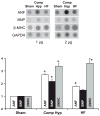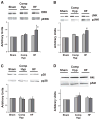Differential activation of stress-response signaling in load-induced cardiac hypertrophy and failure
- PMID: 16033866
- PMCID: PMC4118287
- DOI: 10.1152/physiolgenomics.00061.2005
Differential activation of stress-response signaling in load-induced cardiac hypertrophy and failure
Abstract
Hypertrophic growth of the myocardium occurs in most forms of heart failure and may contribute to the pathogenesis of the failure state. Little is known about the regulatory mechanisms governing the often-coexisting phenotypes of hypertrophy, systolic failure, and diastolic stiffness that characterize clinical disease. We hypothesized that intracellular signaling pathways are differentially activated by graded degrees of hemodynamic stress. To test this, we developed models of graded pressure stress in mice and used them to directly compare compensated hypertrophy and pressure-overload heart failure. Surgical interventions were designed to be similar, on either side of a threshold separating compensated from decompensated responses. Our findings revealed two dramatically different hypertrophic phenotypes with only modest differences in the activation of relevant intracellular signaling pathways. Furthermore, we uncovered a functional requirement of calcineurin signaling in each model such that calcineurin suppression blunted hypertrophic growth. Remarkably, in each case, suppression of calcineurin signaling was not associated with clinical deterioration or increased mortality. Profiles of stress-response signaling and Ca2+ handling differ between the steady-state, maintenance phases of load-induced cardiac hypertrophy and failure. This information may be useful in identifying novel targets of therapy in chronic disease.
Figures








Similar articles
-
Calcineurin/NFAT coupling participates in pathological, but not physiological, cardiac hypertrophy.Circ Res. 2004 Jan 9;94(1):110-8. doi: 10.1161/01.RES.0000109415.17511.18. Epub 2003 Dec 1. Circ Res. 2004. PMID: 14656927
-
Multifarious molecular signaling cascades of cardiac hypertrophy: can the muddy waters be cleared?Pharmacol Res. 2010 Nov;62(5):365-83. doi: 10.1016/j.phrs.2010.07.003. Epub 2010 Jul 17. Pharmacol Res. 2010. PMID: 20643208 Review.
-
Src and multiple MAP kinase activation in cardiac hypertrophy and congestive heart failure under chronic pressure-overload: comparison with acute mechanical stretch.J Mol Cell Cardiol. 2001 Sep;33(9):1637-48. doi: 10.1006/jmcc.2001.1427. J Mol Cell Cardiol. 2001. PMID: 11549343
-
Targeted inhibition of calcineurin in pressure-overload cardiac hypertrophy. Preservation of systolic function.J Biol Chem. 2002 Mar 22;277(12):10251-5. doi: 10.1074/jbc.M110722200. Epub 2002 Jan 10. J Biol Chem. 2002. PMID: 11786544
-
Calcium-calcineurin signaling in the regulation of cardiac hypertrophy.Biochem Biophys Res Commun. 2004 Oct 1;322(4):1178-91. doi: 10.1016/j.bbrc.2004.07.121. Biochem Biophys Res Commun. 2004. PMID: 15336966 Review.
Cited by
-
The type of suture material affects transverse aortic constriction-induced heart failure development in mice: a repeated measures correlation analysis.Front Cardiovasc Med. 2023 Sep 19;10:1242763. doi: 10.3389/fcvm.2023.1242763. eCollection 2023. Front Cardiovasc Med. 2023. PMID: 37795481 Free PMC article.
-
Substrain specific response to cardiac pressure overload in C57BL/6 mice.Am J Physiol Heart Circ Physiol. 2013 Aug 1;305(3):H397-402. doi: 10.1152/ajpheart.00088.2013. Epub 2013 May 24. Am J Physiol Heart Circ Physiol. 2013. PMID: 23709599 Free PMC article.
-
Glucose-regulated protein 78 is essential for cardiac myocyte survival.Cell Death Differ. 2018 Dec;25(12):2181-2194. doi: 10.1038/s41418-018-0109-4. Epub 2018 Apr 17. Cell Death Differ. 2018. PMID: 29666470 Free PMC article.
-
SIRT5 deficiency suppresses mitochondrial ATP production and promotes AMPK activation in response to energy stress.PLoS One. 2019 Feb 13;14(2):e0211796. doi: 10.1371/journal.pone.0211796. eCollection 2019. PLoS One. 2019. PMID: 30759120 Free PMC article.
-
Nitric oxide synthase 3 deficiency limits adverse ventricular remodeling after pressure overload in insulin resistance.Am J Physiol Heart Circ Physiol. 2011 Nov;301(5):H2093-101. doi: 10.1152/ajpheart.00744.2010. Epub 2011 Aug 19. Am J Physiol Heart Circ Physiol. 2011. PMID: 21856905 Free PMC article.
References
-
- American Heart Association. Heart Disease and Stroke Statistics–2004 Update. Dallas, TX: American Heart Association; 2003.
-
- Berenji K, Drazner MH, Rothermel BA, Hill JA. Does load-induced ventricular hypertrophy progress to systolic heart failure? Am J Physiol Heart Circ Physiol. 2005;289:H8–H16. - PubMed
-
- Bowling N, Walsh RA, Song GJ, Estridge T, Sandusky GE, Fouts RL, Mintze K, Pickard T, Roden R, Bristow MR, Sabbah HN, Mizrahi JL, Gromo G, King GL, Vlahos CJ. Increased protein kinase C activity and expression of Ca2+-sensitive isoforms in the failing human heart. Circulation. 1999;99:384–391. - PubMed
-
- Braz JC, Gregory K, Pathak A, Zhao W, Sahin B, Klevitsky R, Kimball TF, Lorenz JN, Nairn AC, Liggett SB, Bodi I, Wang S, Schwartz A, Lakatta EG, DePaoli-Roach AA, Robbins J, Hewett TE, Bibb JA, Westfall MV, Kranias EG, Molkentin JD. PKC-alpha regulates cardiac contractility and propensity toward heart failure. Nat Med. 2004;10:248–254. - PubMed
-
- Brown DW, Giles WH, Croft JB. Left ventricular hypertrophy as a predictor of coronary heart disease mortality and the effect of hypertension. Am Heart J. 2000;140:848–856. - PubMed
Publication types
MeSH terms
Substances
Grants and funding
LinkOut - more resources
Full Text Sources
Miscellaneous

